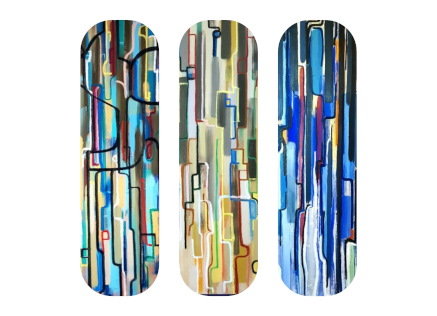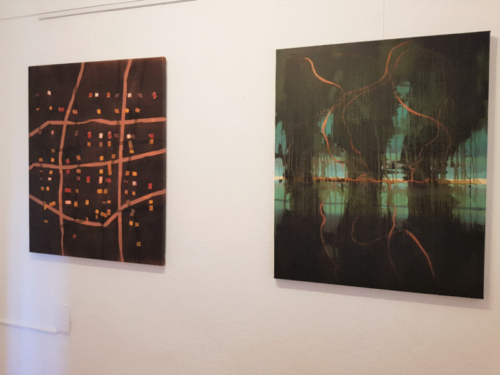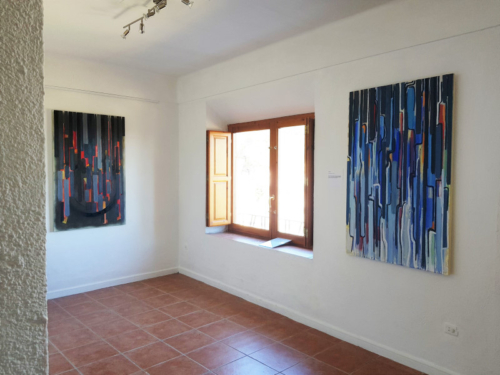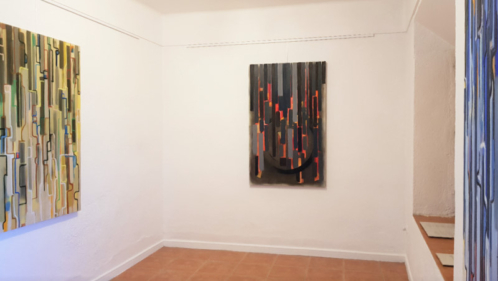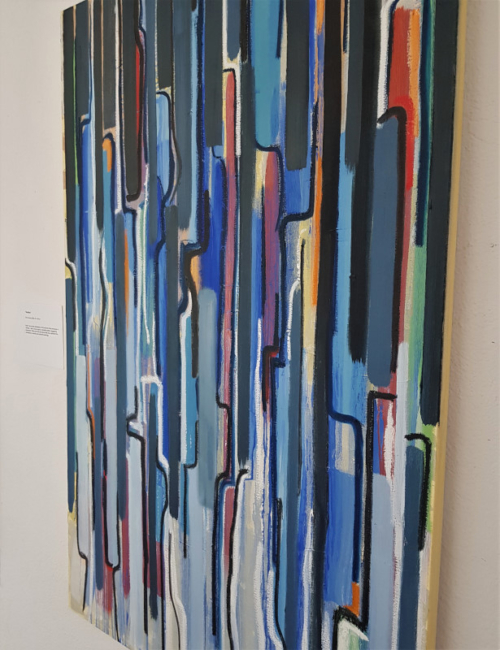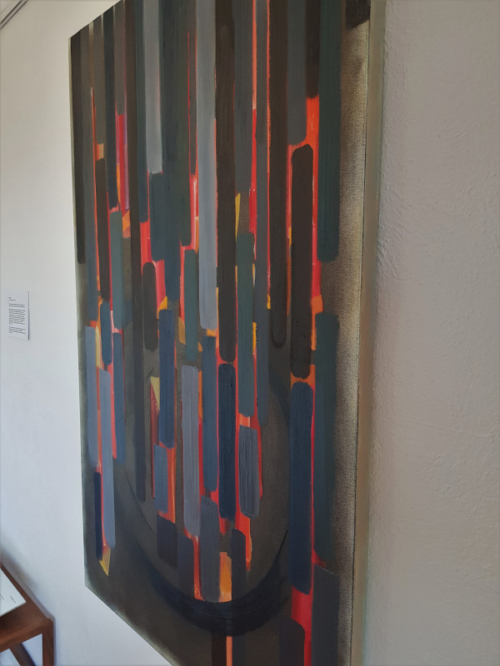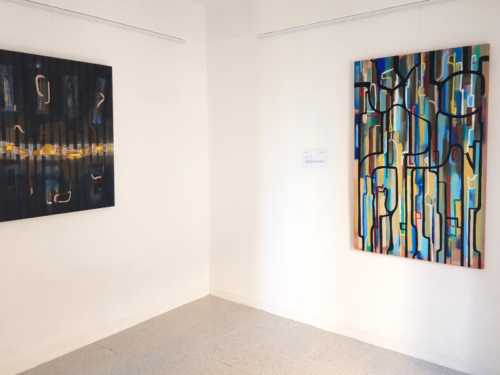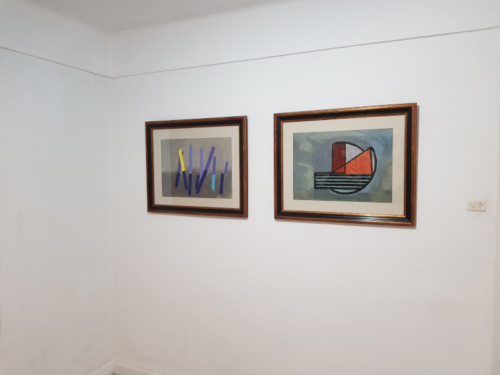Layered Perceptions 18 March – 8 April 2021 Main Gallery
De Souza Gallery is delighted to present “Layered Perceptions”, a solo exhibition and online presentation of paintings by J. Kesín.
The exhibition focuses on the artists latest body of works with the titles “Series Stripes” and ‘Horizons’, both produced during 2020/21, however, a few of his earlier works will also be on show.
The works depict through the application of multiple paint layers the artist’s perception of subjects from such different fields as current affairs, personal experiences, poems or concepts. Each layer may have its own meaning and represent a certain part of the subject, whether concrete or perceived, thus incorporating a constructed quality into the works. Yet the symbiosis of a somewhat analytical approach with spontaneous decisions towards the application / removal or covering up of paint strikes a satisfying balance in the finished works.

Exhibits from Series ‘Stripes’
Kesín’s series of works, ‘Stripes’ comprises abstract manifestations of the painters perception of different subjects. ‘Panther’, a visualisation of Rilke’s poem was the starting point of the series and initiated the artist’s desire to explore the possibilities of combining different layers and aspects of a subject into one cohesive painting. Kesín uses various layering techniques and the paint application is mostly limited to vertical lines / stripes. The choice of colours and their application is partly deliberate and analytical and partly intuitive.
Subsequent works in this series, have so far been concerned with places and times that had a significant meaning for the artist. Here the different layers may represent facets like landscape, architecture, people, history, events….yet always through the lens of personal memory, encounters, thoughts and emotions.
Panther
2020, 81 x 130 cm, Oil on Canvas
“The Panther” (subtitled: “In Jardin des Plantes, Paris”; German: “Der Panther: Im Jardin des Plantes, Paris”) is a poem by Rainer Maria Rilke written on 6 November 1902. It describes a captured panther behind bars, as it was exhibited in the Ménagerie of the Jardin des Plantes in Paris. It is one of Rilke’s most famous poems and has been translated into English many times, including by many distinguished translators of Rilke…
Source: Wikipedia
‘Panther’ is an almost sequential and literal work, with many of the aspects of the poem recognisably visualised in the different layers.
The first transluscent layers of the background are split into brighter tones representative of an (imagined) life before the animal’s capture, followed by more sombre ones symbolising its life in Paris.
Kesín paints the circle twice. In the lower layer it represents the monotony of the panther’s life, the circular walk around his cage, as well as his pupil (‘Only at times the curtain of the pupil Slides up’).
Dark stripes form the animals cage, and are also threatening to cover the whole painting when the animal seems to have given up. Yet, there remains a glimmer of hope for the panther’s future, as the second circle has not yet fully closed, and the bright reds representative of the panther itself and of his subdued strong will still shine through.

The Panther
His gaze, from the passing of the bars,
Has grown so weary, it cannot hold anything anymore.
He feels as if there were a thousand bars,
And behind the thousand bars no world.
The soft tread of supple strong steps
That turns in the tiniest of circles
Is like a dance of strength around a center
Wherein a mighty will stands, paralyzed.
Only at times the curtain of the pupil
Slides up, without a sound – . Then a picture enters,
Goes through the limbs tense stillness,
And in the heart ceases to be.
Antibes
2020, 81 x 130 cm, Oil on Canvas
Kesín has a clear emphasis on the colours of sky and seas in ‘Antibes’, with a more organic, wavelike pattern suggesting movement. There are hints of vivid colours that may represent the architecture, markets and colourful awnings.

Luxor
2020/21, 81 x 130 cm, Oil on Canvas
In ‘Luxor’ the viewer may perceive amongst others the colours of the desert, Egypt’s golden history, dark tomb walkways, fresh and ancient blood, or the colours of children’s sun bleached clothes as they play. Lines of blues and greens may remind the viewer of the Nile and its banks, and overlayed graphics seem to take on shapes reminiscent of ancient stelae.

Khiva
2020/21, 81 x 130 cm, Oil on Canvas
In ‘Khiva’ the blues and turquoises of the tiled domes are a clear feature. We are reminded of the Kyzylkum Desert and of the brickwork of the old town with colours of ochre and sable. The black confining graphics of the top layer, resembling ironwork, are possibly hinting at the suppression of the Uzbeks under Soviet rule and then later, the broken promise of democratisation.
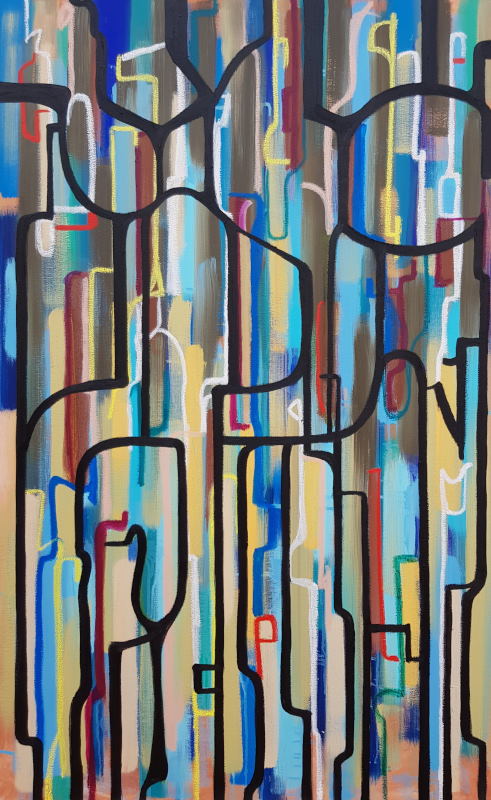
Moscow
2021, 81 x 130 cm, Oil on Canvas
Kesín depicts ‘Moscow’ with a more rigid structure. One of the upper layers covers the whole painting in a translucent ‘whitewash’ suggesting the viewer may be looking through a window in the rain or a snowstorm. The visibility of the lower parts of the painting is therefore obscured.
Thicker stripes, and horizontal and vertical lines of the top layer dominate the work. The thick stripes might represent old and new Russia, symbolised through the pastel and mustard colours of old architecture and a darker stark new skyline. This strong contrast may also hint at societal inequalities like extreme wealth versus poverty.
The divide between the obscured lower layers and the solid top layer could be hinting at clear and choregraphed political messages and attempts of reconstruction and alteration of history, with many layers and connections that as a whole would make up the true picture hardly visible any more.

Exhibits from Series ‘Horizons’
Kesín’s series of works, ‘Horizons’ continues the theme of abstract manifestations but focuses more on current affairs and general concepts. The constraints of the strong vertical orientation give way to less uniform compositions, even though horizons become the unifying characteristic. Still various layering techniques are being used, but more emphasis is placed on the application of thin, transparent layers.
All the Sunsets
2020/21, 81 x 100 cm, Oil on Canvas
Kesín applies multiple translucent layers of different colours, each creating lines of imagined horizons with overlapping ‘suns’ at the intersections, revealing a multitude of possible combinations. This gives the work its visual depth, as the layers further back become less and less visible, implying, theoretically an infinite number of horizons and suns that are not visible to the eye.

Born of the Shallows
2021, 81 x 130 cm, Oil on Canvas
In Born of the Shallows Kesín contrasts layered colour fields which form a background resembling shallow waters, meeting at or emerging from both sides of a light coloured ‘horizon’.
From these shallows dark shapes or clouds and lines resembling lightning appear and threaten to engulf the whole picture. Attempts were made to disperse or eradicate this phenomena, but the outcome is unclear. Even though the shallows themselves look calm and harmless, the threatening shapes created here do not.
Born of the Shallows could be read as an allegory for the ‘shallow’ and populist nature of certain parts of media and politics, which might at first not be taken seriously but whose actions may have unforeseen results.
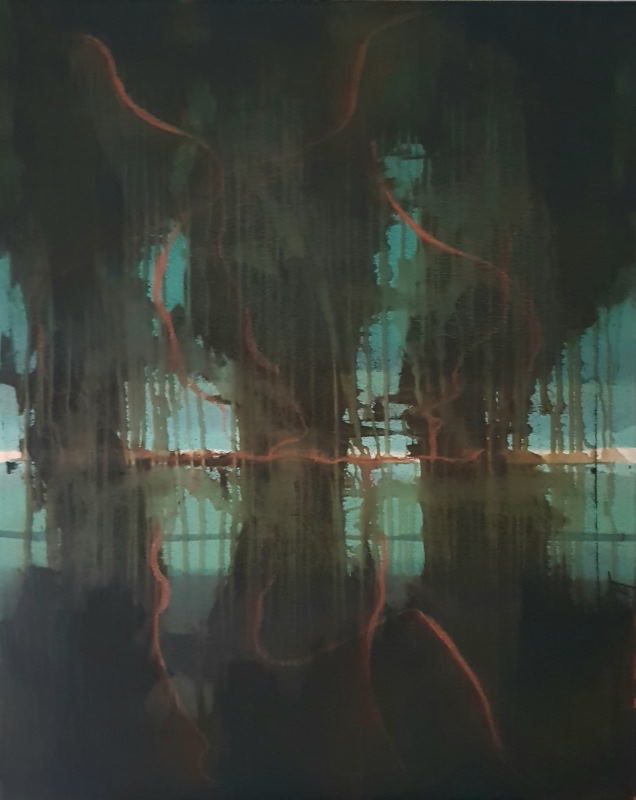
Truth Windows
2021, 81 x 100 cm, Oil on Canvas
By definition a truth window is an opening in a wall surface, created to reveal what lies behind the plaster (i.e. straw / rock).
‘Truth Windows’ works with many layers of paint to experiment with this idea, and asks about truth in a more general context.
It reveals several ‘openings’, where the top paint layers have been omitted. Looking at these openings you realise that even within a truth window may lie fully or partly hidden layers behind the visible surface.
‘Truth’ refers here to the construction of the painting and may be synonymous with different concepts:
According to the idea of ‘truth windows’ the truth would be the whole canvas stripped of the layers that were applied later thus creating the truth openings. But as there would still be paint layers underneath, this would only show a superficial truth. In fact, a completely different painting might be hidden behind the visible layers.
Truth might therefore be the whole canvas with the painting deconstructed into its numerous layers, making these visible individually.
It may also include the unpainted canvas underneath the painting, or possibly go even further to include the frame…. Furthermore the sides of the canvas can not all be visible to the eye at the same time, canvas and layers will look different in different lighting conditions and when being seen from different angles / perspectives.
What becomes clear is that it is not possible to view the ‘whole’ truth of the painting. We can not look behind the surface of the truth windows let alone the rest of the canvas, nor deconstruct it into its individual layers. We can only make deductions or assumptions from what is visible to us and come to more or less accurate approximations.

Launch of the seven Factoids
2021, 100 x 81 cm, Oil on Canvas
This addresses the seemingly growing phenomena of ‘alternative’ or ‘unproven’ ‘facts’ in media and politics. The specific factoids in the painting seem to be somehow connected, possibly being part of a larger propaganda effort. They may look real and solid, but for the most part their actual nature is partly obscured by various layers of paint.
Far in the background are other shapes or structures, possibly hinting at either the true facts or hidden intentions or operatives that lie behind the release of the factoids.
The scriptlike lines that reach towards the factoids, may relate to a discourse around the topic in question, but it is not clear if they are aiding the release or trying to prevent it.
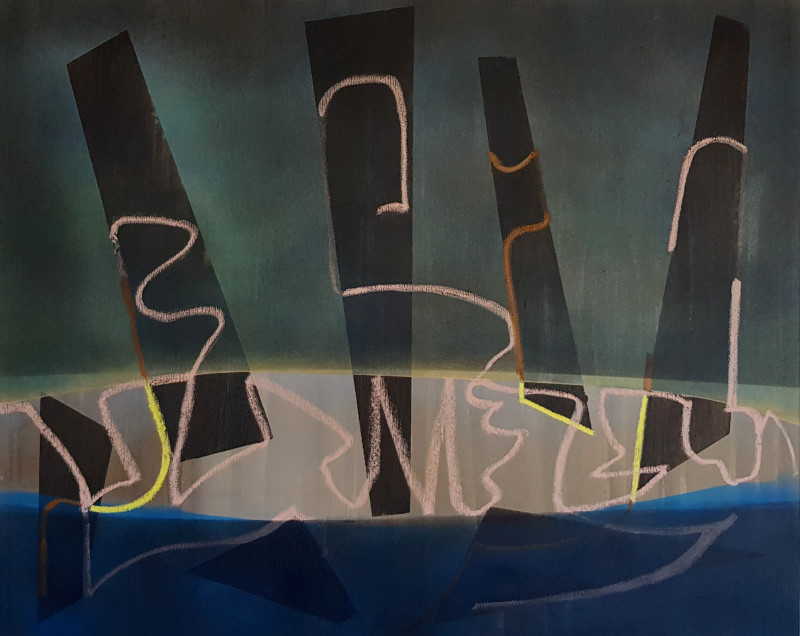
Installation Views
About J. Kesín
The artist J. Kesín was born in Germany. He has an MA in Cultural Studies and has lived the larger part of his adult life in the UK and Spain. He also spent extended periods of time in Russia and Uzbekistan in the years following the break up of the Soviet Union.
Originally self taught and experimenting with different techniques over the years, he went on to train formally, and is now fully concentrating on his art.
His work is influenced amongst others by the earlier period of abstraction and artists like Kupka and his ‘verticals’, and by abstract expressionism. Kesin usually works with different layers, sometimes involving colour fields, yet usually with a strong graphic, sometimes geometric aspect.

